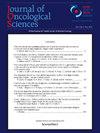Prognostic Significance of Mucinous Histology in Metastatic Colorectal Cancer Patients Treated with Regorafenib
Q4 Medicine
引用次数: 0
Abstract
ABS TRACT Objective: Prognostic factors for regorafenib therapy have not been fully defined. Mucinous adenocarcinoma (MAC) is a distinct subtype of colorectal cancer (CRC). We investigated the significance of mucinous histology in patients treated with regorafenib for metastatic CRC (mCRC). Material and Methods: In this retrospective study, patients were stratified according to the presence of mucinous histology; >1% extracellular mucin was defined as mucinous component adenocarcinoma (MCAC), and containing no mucin was defined as non-MAC. The prognostic significance of mucinous histology for progression-free survival (PFS) and overall survival (OS) was evaluated by univariate and multivariate analyses. Results: A total of 103 patients were included, including 20 (19.4%) patients with MCAC and 83 (80.6%) patients with non-MAC. The median follow-up time was 8.6 months (range 1.8-31.6 months). The median PFS was lower in cases with MCAC than those with non-MAC (3.2 months vs. 3.6 months, respectively, p=0.01). Median OS was lower in MCAC patients than in non-MAC patients (4.3 months vs. 9.6 months, respectively, p=0.008). In multivariate analyses, mucinous histology was an independent risk factor [hazard ratio (HR): 2.2, p=0.003] for PFS and Eastern Cooperative Oncology Group-Performance Status (HR: 2.2, p=0.01), cancer antigen 19-9 (HR: 1.7, p=0.03), and mucinous histology (HR: 1.9, p=0.02) were independent risk factors for OS. Conclusion: This study revealed the prognostic value of mucinous histology in mCRC patients treated with regorafenib. Consideration of histologic features may be helpful in selecting patients for regorafenib therapy.瑞非尼治疗转移性结直肠癌患者黏液组织学的预后意义
目的:瑞非尼治疗的预后因素尚未完全确定。粘液腺癌(MAC)是结直肠癌(CRC)的一个独特亚型。我们研究了在接受瑞非尼治疗的转移性结直肠癌(mCRC)患者中粘液组织学的意义。材料和方法:在这项回顾性研究中,根据有无粘液组织学对患者进行分层;1%细胞外粘蛋白定义为黏液成分腺癌(MCAC),不含粘蛋白定义为非黏液成分腺癌。通过单因素和多因素分析评估黏液组织学对无进展生存期(PFS)和总生存期(OS)的预后意义。结果:共纳入103例患者,其中MCAC患者20例(19.4%),非mac患者83例(80.6%)。中位随访时间8.6个月(1.8-31.6个月)。MCAC患者的中位PFS低于非mac患者(分别为3.2个月和3.6个月,p=0.01)。MCAC患者的中位OS低于非mac患者(分别为4.3个月和9.6个月,p=0.008)。在多因素分析中,粘液组织学是PFS和东部肿瘤合作组的独立危险因素[危险比(HR): 2.2, p=0.003],肿瘤抗原19-9 (HR: 1.7, p=0.03)和粘液组织学(HR: 1.9, p=0.02)是OS的独立危险因素。结论:本研究揭示了瑞非尼治疗mCRC患者的粘液组织学预后价值。考虑组织学特征可能有助于选择接受瑞非尼治疗的患者。
本文章由计算机程序翻译,如有差异,请以英文原文为准。
求助全文
约1分钟内获得全文
求助全文
来源期刊

Journal of Oncological Sciences
Medicine-Oncology
CiteScore
0.10
自引率
0.00%
发文量
16
审稿时长
29 weeks
 求助内容:
求助内容: 应助结果提醒方式:
应助结果提醒方式:


